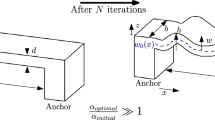Abstract
An optimised structure is one which uses the smallest quantity of the best material to perform its function, with adequate safety factor or margin for error. Structural optimisation occurs not only in mechanical engineering, but also in nature: plants with hollow stems or stalks gain a height advantage, and are thus more efficient, by approaching the optimum shape. Here we consider the optimisation of orthotropic tubes, typifying, in a mechanical sense, stalk and stem. The stiffness and strength of orthotropic tubes of initially circular section are reviewed, and diagrams are proposed which allow the optimum section shape to be selected.






Similar content being viewed by others
References
Amada S, Munekata T, Nagase Y, Ichikawa Y, Kirigai A, Yang ZF (1996) J Comp Mat 30:800
Arce-Villalobos OA (1993) Fundamentals of the design of bamboo structures. PhD Thesis, Eindhoven University of Technology, Netherlands
Niklas KJ (1989) Am J Bot 76:521
Niklas KJ (1992) Plant biomechanics: an engineering approach to plant form and function. University of Chicago Press, Chicago
Niklas KJ (1995) Ann Bot 75:133
Niklas KJ (1997a) Ann Bot 80:275
Niklas KJ (1997b) Ann Bot 80:437
Niklas KJ (1998) Ann Bot 81:11
Spatz HC, Speck T, Vogellehner D (1990) Bot Acta 103:123
Spatz HC, Boomgaarden C, Speck T (1993) Bot Acta 106:254
Spatz HC, Speck T (1994) Biomimetics 2:149
Spatz HC, Kohler L, Speck T (1998) Am J Bot 85:305
Speck T, Speck O, Emanns A, Spatz HC (1998) Bot Acta 111:366
Schulgasser K, Witztum A (1997) Ann Bot 80:35
Cecchini LS, Weaver PM (2002) AIAA J 40:2136
Corona E, Rodrigues A (1995) Comp Eng 5:163
Fabian O (1977) Int J Sol Struct 13:1257
Gerard G (1968) Minimum weight design of compressive structures. New York University Press/Interscience, New York
Harursampath D, Hodges DH (1999) Int J Non-Linear Mech 34:1003
Kedward KT (1978) In: Proceedings of the 2nd international conference on composite materials (ICCM/2). Met Soc of AIME p 353
Libai A, Bert CW (1994a) Int J Sol Struct 31:1003
Libai A, Bert CW (1994b) Int J Sol Struct 31:1019
NASA (1968) Space vehicles design criteria (structures)—buckling of thin-walled circular cylinders. Technical Report NASA SP-8007, NASA
Tatting BF, Gürdal Z, Vasiliev VV (1996) AIAA J 34:1934
Tatting BF, Gürdal Z, Vasiliev VV (1997) Int J Solids Struct 34:1419
Tsai SW, Wu EM (1971) J Comp Mater 5:58
Schulgasser K, Witztum A (1992) J Theor Biol 155:497
Brazier LG (1927) Proc Roy Soc Lond A 116:104
Calladine CR (1983) Theory of shell structures. Cambridge University Press, Cambridge
Ghavami K (1990) In: Ramanuja Rao I, Gnanaharan R, Sastry C (eds) Proceedings of the international bamboo workshop held in Cochin, India, 14–18 November. The Kerala Forest Research Institute, India and International Development Research Centre, Canada, p 235
Li S, Fu S, Zeng Q, Zhao X, Zhou B (1994) Biomimetics 2:15
Oda J (1980) Trans Japan Soc Mech Eng Ser A 46:997
Ueda K (1980) Res Bull Coll Exp For Hokkaido University 37:817
Akselrad EL (1965) Izv Akad Nauk USSR, Otdelenie Teknicheskikh Nauk Mech No 4:123
Seide P, Weingarten V (1961) J Appl Mech 28:112
Suo Z (1990a) J Appl Mech 57:627
Suo Z (1990b) Proc R Soc Lond A 427:331
Wegst UGK, Ashby MF (2004) Phil Mag 84:2167
Karam GN, Gibson JL (1995a) Int J Sol Struct 32:1259
Karam GN, Gibson JL (1995b) Int J Sol Struct 32:1285
Young WC (1989) Roark’s formulas for stress and strain, 6th edn. McGraw-Hill, London
Mosbrugger V (1990) The tree habit in land plants. Lecture notes in Earth Sciences: 28. Springer, Berlin
Liese W (1985) Bamboos: biology, silvics, properties, utilization (Schriftenreihe der GTZ, Nr. 180, Deutsche Gesellschaft für Technische Zusammenarbeit (GTZ) GmbH, Dag-Hammerskjöld-Weg 1+2, D-65760 Eschborn, Germany)
Acknowledgements
The ideas presented here have been helped by discussions with numerous colleagues and associates. We particularly wish to acknowledge the inputs and suggestions of Prof. C.R. Calladine, Dr. H. R. Shercliff, Dr. P. M. Weaver and of an anonymous reviewer. We also wish to acknowledge the support of the Royal Society of London and the US Advance Research Project Agency through the University Research Initiative under Office of Naval Research Contract No. N-00014092-J-1808.
Author information
Authors and Affiliations
Corresponding author
Appendices
Appendix 1 full solution for ϕA
The transition from fracture/yield to splitting is found by equating the respective moments of failure at A:
with
Appendix 2 failure through inadequate stiffness
The final criterion for the macroscopical mechanical performance is that of stiffness. Mosbrugger [42] classifies plants according to their structural behaviour: either the plant is a ’flexibility strategist’ and reduces external loads by bending or it is a ’stability strategist’ and has a structure which is stiff and strong enough to withstand the loads without much bending. As the principal load is that due to wind and the velocity of wind increases with height above ground, a flexible tree which bends in a strong wind reduces the moment arm of the net wind force, especially if elastic deformation of its crown reduces its down-wind profile. Tree trunks are frequently stability strategists, whereas their branches must be capable of bending to a quarter-circle. The curvature of the bamboo culm, C, can then be expressed as a function of the length, l, of the stem
Substituting this expression for C in Eq. 8 and inserting the result for c in Eq. 13b gives the bending moment, M, which bends the stem into a quarter-circle
The second expression in the square bracket is very small due to the high slenderness ratios of bamboo (ϕ = l/r = 550−1000, [43]) and may therefore be neglected. The moment which bends a stem to a quarter-circle may therefore be rewritten as
If the plant is to function as a flexibility strategist, it must be able to do this without failing by any of the other three mechanisms analysed above.
Rights and permissions
About this article
Cite this article
Wegst, U.G.K., Ashby, M.F. The structural efficiency of orthotropic stalks, stems and tubes. J Mater Sci 42, 9005–9014 (2007). https://doi.org/10.1007/s10853-007-1936-8
Received:
Accepted:
Published:
Issue Date:
DOI: https://doi.org/10.1007/s10853-007-1936-8




